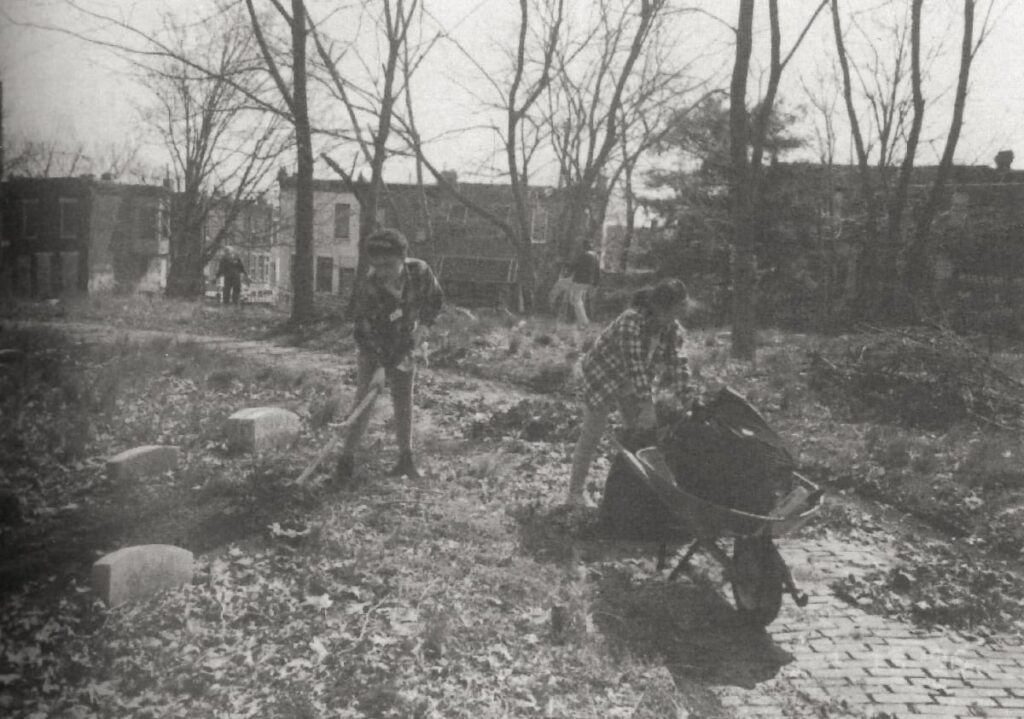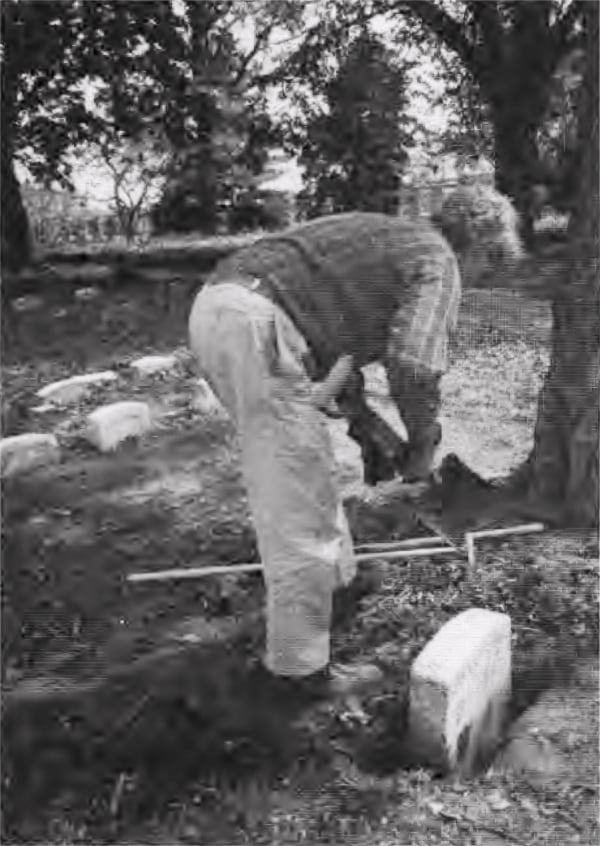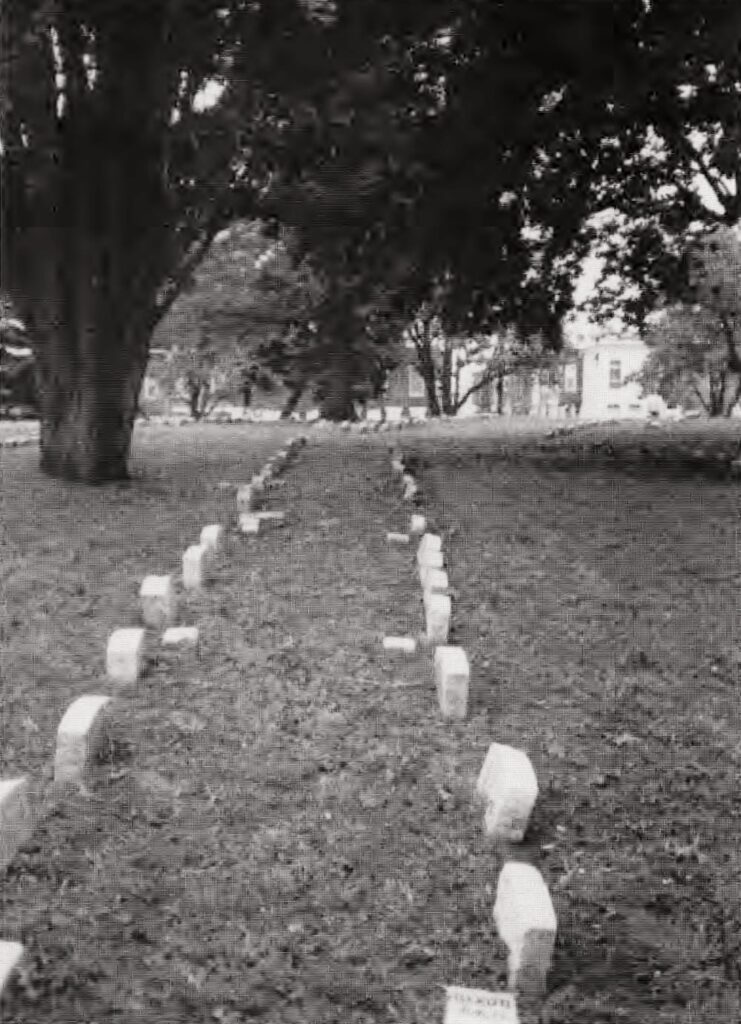
On land once given to the Religious Society of Friends by George Fox sits the Fair Hill Burial Ground in North Philadelphia. Only a few years ago it appeared abandoned, a tangle of weeds, discarded tires, trash, and garbage, surrounded by a gap toothed fence and gutted sidewalks, a menace to an already decaying neighborhood. On its northeast corner drug dealers gathered like flies, while their clients used the burial ground to shoot up. Neighborhood children were kept indoors to avoid the flying bullets of gang warfare.
Today, the burial ground has been returned to its former state of serenity and beauty, the drug dealers are gone, the sidewalks have been restored, and funds are being raised to replace the stolen sections of the fence. Neighbors and children from a nearby school work with Quaker volunteers from all over to plant flowers. Tourists can again visit the historic area with impunity. The United States Park Service has recently placed the burial ground on the National Register of Historic Places.
The change seems miraculous, and perhaps it is. But behind it lies the indomitable spirit of a woman who was buried here over 100 years ago. Lucretia Coffin Mott spent a long lifetime fighting for better conditions for blacks, women, Native Americans, and the working classes. When it was suggested in the 1980s that her grave be moved downtown to a better neighborhood, those tuned in to her spirit knew she would bristle at the mere idea. Instead, it seemed clear that she would want her admirers to do something about the Fair Hill neighborhood itself. And although it seemed like an effort doomed to failure, a small group met to consider what they could possibly do.




The first step was to buy back the burial ground, which had been sold to a local minister. Selling the burial ground had seemed in the early 1980s the right action, as Friends had long since moved away from the neighborhood, and the minister was using the meetinghouse as a church. There had been a misunderstanding about the maintenance of the burial ground however, and it had begun to slide into decay. LIFE Magazine wrote an article about North Philadelphia in which it described the burial ground as a site for drug dealing, rape, and satanic rites, a menace to the neighborhood, and the Philadelphia Inquirer picked up the story. A few neighbors decided to band together and come to Friends Center at 15th and Cherry Streets to ask if something could not be done. This initiative, coming at the same time as the question of moving the Mott grave, galvanized the small group of interested Friends to action. A Fair Hill Burial Ground Corporation was formed under Philadelphia Quarterly Meeting, made up of representatives from all the meetings of the quarter, and funds were solicited from those meetings and various Quaker foundations to repurchase the burial ground. Negotiation with the owner resulted in the transfer of ownership back into Quaker hands in the spring of 1993.
Then began a cleanup process without precedent. Three times a year, in April, July, and October, Friends have gathered from far and near to help restore the burial ground. Some meetings choose one cleanup a year as a meeting event and bring many volunteers to help. Friends schools have also sent squadrons armed with rakes and shovels. A busload from New Garden Friends School in North Carolina put in a day of hard work. Swarthmore College has sent volunteers.
At first, volunteers picked up—with great care-buckets—full of hypodermic needles. There were also ‘dumpsters full of trash, including an abandoned and rusted car. Because the grave stones are small, neighbors had thought it was a pet cemetery and had contributed a few dead dogs and cats to the trash piles. Weeds and weed trees had grown up and had to be cut down; existing trees were pruned. While volunteers worked on one side of the fence, the drug dealers still plied their trade on the other. Sometimes shots rang out, and the volunteers wondered if they were risking their lives.
But slowly, the miracle began to happen. Former drug addicts in a local recovery program were engaged to keep the trash down from week to week. A teacher from the Julia de Burgos Middle School became interested and brought a class working on environmental issues to help with the cleanup and planting. Later they decided to plant a tree farm and to act out a play in which James and Lucretia Mott come back from heaven to confront the president and demand an end to the drug trade. The Philadelphia district attorney became one of the volunteers. The Mural Arts Program painted a neighboring wall with a picture of Mott and of others who had participated in the antislavery campaign, as well as Barbara Moffett of the AFSC who published Martin Luther King’s Letter from a Birmingham Jail.
Neighbors were consulted in the planning of the restoration. While they would like to see the day when the neighborhood can use the gardens for special events, their primary concern was that the Fair Hill Burial Ground be restored to its former state of beauty. Meanwhile a group of neighbors took heart and organized a garden and playground for the children on nearby Hutchinson Street. The miracle was made up of a number of small acts of courage and devotion, by those determined to see what love can do.
While the spirit of Lucretia Mott has been the guiding force in the restoration of the Burial Ground, there have been many others to inspire the volunteers, going back over 300 years. William Penn himself gave George Fox the land in the “liberties” where Fair Hill Burial Ground now sits. Isaac Norris went to the meeting that once was held there. Revolutionary soldiers were cared for in the meetinghouse, long since torn down, to the south of the burial ground.
In 1843, when the present burial ground was laid out to accommodate the Hicksite meetings in the city, many Friends were concerned to rid the nation of slavery. The radicals among them formed a network around James and Lucretia Mott, who were friends and colleagues of William Lloyd Garrison. James Mott was also a chief fundraiser for the new burial ground. As a result some members of the Garrisonian Pennsylvania Anti-Slavery Society were buried at Fair Hill cemetery. Among them are Sarah Pugh and Abigail Kimber, school teachers who accompanied Lucretia Mott to London to attend the World Anti-Slavery Convention in 1840. Excluded because of their gender, they supported Lucretia Mott and the young wife of a delegate, Elizabeth Cady Stanton, when they agreed to return to the United States to work for women’s rights.
Other activists buried at Fair Hill include Edward M. Davis, the Motts’ son in-law, who gave his farm for the training of the first all-black U. S. army regiment, and Robert Purvis, an African American who founded the first underground railroad in the Philadelphia area. Not a Friend, though a friend of Friends, Purvis was married first to Harriet Forten, daughter of the famous James Forten, sailmaker. He probably bought a family lot at Fair Hill because of his friendship with the Motts. Harriet was also an activist, serving with the interracial Philadelphia Female Anti-Slavery Society. She along with a daughter and a daughter-in-law as well as Robert Purvis’s mother are buried at Fair Hill. They are one of very few African American families to be buried in a Quaker burial ground during the 19th century.
Thomas and Mary Ann McClintock, active in antislavery, began their work in Philadelphia, moved to Waterloo, New York, and returned to Philadelphia in later years. While at Waterloo, Mary Ann McClintock was one of five women present at the famous tea party where the Seneca Falls Convention of 1848 for Woman’s Rights was organized, and the next day she hosted a second meeting at her house where the Declaration of Women’s Rights was written.
Both James Mott and Robert Purvis were also members of the Pennsylvania Abolition Society. So was Henry Laing, who served as treasurer for that organization for many years. A school established for former slaves near Charleston, South Carolina, was named for him. Daniel Neall, also an Abolition Society member, was chair of the group that built Pennsylvania Hall in 1838 as a gathering place for abolitionists, only to see it burned down by an angry proslavery mob. Anna Jeanes kept the liberal tradition alive by funding schools for freedmen and founding the Jeanes Fund to help rural black schools in the South enrich their curriculum.
The burial ground also has many ties to Quaker schools and colleges. Edward Parrish, first president of Swarthmore College, is buried at Fair Hill. So is Anna Mott Hopper, Lucretia Mott’ s daughter and a member of Swarthmore’s board of managers. Altogether, 11 members of the early corporation, 4 teachers, and 21 students from the early years joined Edward Parrish at Fair Hill. Friends Aaron B. Ivins, principal of Friends Central School 1855- 1883; and Lydia Gillingham, principal of the girl’s department 1853- 1875, are among faculty buried there.
These voices from the past are joined by the many men and women, boys and girls of the present who have given time, energy, and resources to bring the burial ground back to a state of beauty and serenity that makes it an asset, rather than a deficit, to the people of the neighborhood. Some day, a neighbor predicted, it will be like the Betsy Ross house, an attraction bringing tourists and resources to the neighborhood.
Lucretia Mott might scoff at being compared to Betsy Ross. But she would be pleased that her presence is making a positive difference in a neighborhood’s redevelopment. And she would not consider the change a miracle. Hadn’t she started with a mere handful to launch the antislavery movement? With four other women to launch the woman’s rights movement? “Though they [the reformers] may be few in number and weak in force,” she once said at Race Street Meeting, quoting First Corinthians, “it may be said again, ‘I have chosen the weak things to confound the strong and the wise.'” Faith like that can move mountains.


